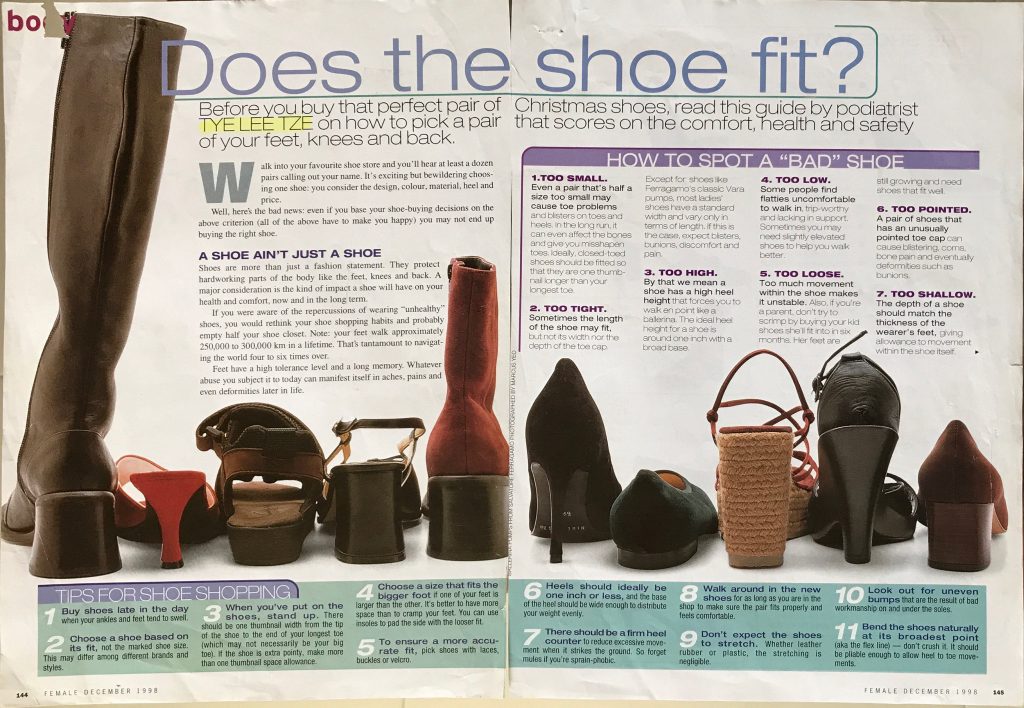Before you buy that perfect pair of Christmas shoes, read this guide by podiatrist TYE LEE TZE on how to pick a pair that scores on the comfort, health and safety of your feet, knees and back.
Walk into your favourite shoe store and you’ll hear at least a dozen pairs calling out your name. It’s exciting but bewildering choosing one shoe: you consider the design, colour, material, heel and price.
Well, here’s the bad news: even if you base your shoe-buying decisions on the above criterion (all of the above have to make you happy) you may not end up buying the right shoe.
A shoe ain’t just a shoe
Shoes are more than just a fashion statement. They protect hardworking parts of the body like the feet, knees and back. A major consideration is the kind of impact a shoe will have on your health and comfort, now and in the long term.
If you were aware of the repercussions of wearing “unhealthy’ shoes, you would rethink your shoe shopping habits and probably empty half your shoe closet. Note: your feet walk approximately 250,000 to 300.000 km in a lifetime. That’s tantamount to navigating the world four to six times over.
Feet have a high tolerance level and a long memory. Whatever abuse you subject it to today can manifest itself in aches, pains and even deformities later in life.
How to spot a “bad” shoe
1. Too small
Even a pair that’s a half a size too small may cause toe problems and bister on toes and heels. In the long run, it can even affect the bones and give you misshapen toes. Ideally, closed-toed shoes should be fitted so that they are one thumbnail longer than your longest toes.
2. Too tight
Sometimes the length of the shoe may fit, but not its width not the depth of the toe cap. Except for shoes like Ferragamo’s classic Vara pumps, most ladies’ shoes have a standard width and vary only in terms of length. If this is the case, expect blisters, bunions, discomfort and pain.
3. Too high
By that we mean a shoe that has a high heel height that forces you to walk en point like a ballerina. The idea heel height for a shoe is around one inch with a broad base.
4. Too low
Some people find flatties uncomfortable to walk in, trip-worthy and lacking in support. Sometimes you may need slightly elevated shoes to help you walk better.
5. Too loose
Too much movement within the shoe makes it unstable. Also, if you’re a parent, don’t try to scrimp by buying your kids shoes she’ll fit into in six months. Her feet are still growing and need shoes that fit well.
6. Too pointed
A pair of shoes that has an unusually pointed cap can cause blistering, coms, bone pain and eventually deformities such as bunions.
7. Too shallow
The depth of a shoe should match the thickness of the wearer’s feet, giving allowance to movement within the shoe itself.
Tips for shoe shopping
- Buy shoes late in the day when your ankles and feet tend to swell.
- Choose a shoe based on its fit, not the marked shoe size. This may differ among different brands and styles.
- When you’ve put on the shoes, stand up. There should be one thumbnail width from the tip of the shoe to the end of your longest toe (which may not necessarily be your biggest toe). If the shoe is extra pointy, make more than one thumbnail space allowance.
- Choose a size that fits the bigger foot if one of your feet is larger than the other. It’s better to have more space than to cramp your feet. You can use insoles to pad the side with the looser fit.
- To ensure a more accurate fit, pick shoes with laces, buckles or velcro.
- Hells should ideally be one inch or less, and the base of the heel should be wide enough to distribute your weight evenly.
- There should be a firm heel counter to reduce excessive movement when it strikes the ground. So forget mules if you’re sprain-phobic.
- Walk around in the new shoes for as long as your are in the shop to make sure the pair fits properly and feels comfortable.
- Don’t expect to shoes to stretch. Whether leather, rubber or plastic, the stretching is negligible.
- Look out for uneven bumps that are the result of bad workmanship on and under the soles.
- Bend the shoes naturally at its broadest point (aka the flex line) – don’t crush it. It should be pliable enough to allow heel to toe movement.

